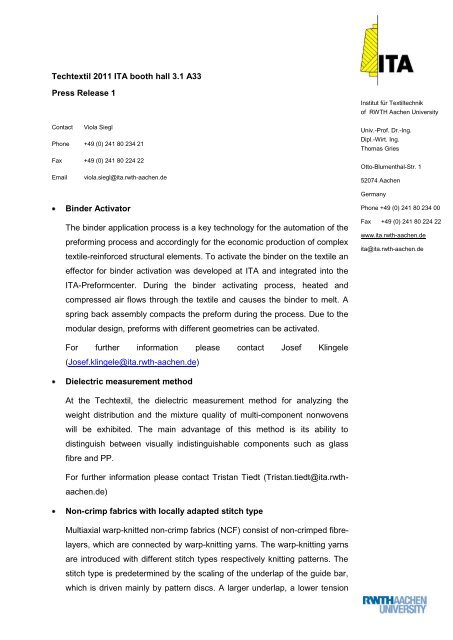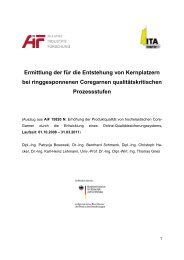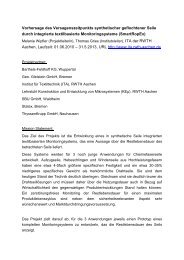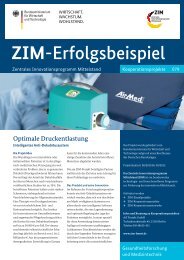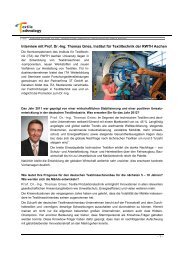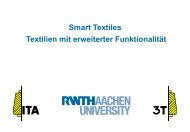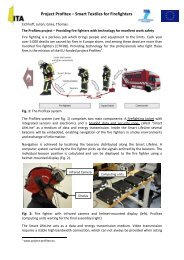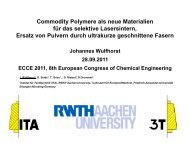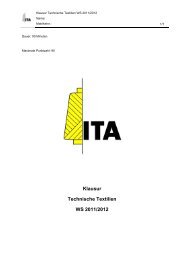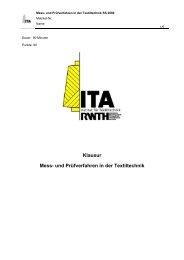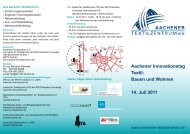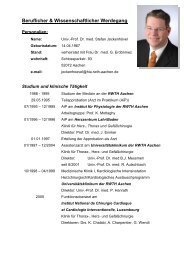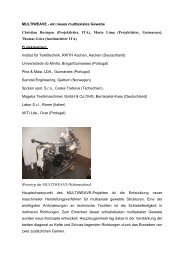ITA-Formblatt-Vorlage deutsch - Institut für Textiltechnik - RWTH ...
ITA-Formblatt-Vorlage deutsch - Institut für Textiltechnik - RWTH ...
ITA-Formblatt-Vorlage deutsch - Institut für Textiltechnik - RWTH ...
Create successful ePaper yourself
Turn your PDF publications into a flip-book with our unique Google optimized e-Paper software.
Techtextil 2011 <strong>ITA</strong> booth hall 3.1 A33<br />
Press Release 1<br />
Contact Viola Siegl<br />
Phone +49 (0) 241 80 234 21<br />
Fax +49 (0) 241 80 224 22<br />
Email viola.siegl@ita.rwth-aachen.de<br />
Binder Activator<br />
The binder application process is a key technology for the automation of the<br />
preforming process and accordingly for the economic production of complex<br />
textile-reinforced structural elements. To activate the binder on the textile an<br />
effector for binder activation was developed at <strong>ITA</strong> and integrated into the<br />
<strong>ITA</strong>-Preformcenter. During the binder activating process, heated and<br />
compressed air flows through the textile and causes the binder to melt. A<br />
spring back assembly compacts the preform during the process. Due to the<br />
modular design, preforms with different geometries can be activated.<br />
For further information please contact Josef Klingele<br />
(Josef.klingele@ita.rwth-aachen.de)<br />
Dielectric measurement method<br />
At the Techtextil, the dielectric measurement method for analyzing the<br />
weight distribution and the mixture quality of multi-component nonwovens<br />
will be exhibited. The main advantage of this method is its ability to<br />
distinguish between visually indistinguishable components such as glass<br />
fibre and PP.<br />
For further information please contact Tristan Tiedt (Tristan.tiedt@ita.rwth-<br />
aachen.de)<br />
Non-crimp fabrics with locally adapted stitch type<br />
Multiaxial warp-knitted non-crimp fabrics (NCF) consist of non-crimped fibre-<br />
layers, which are connected by warp-knitting yarns. The warp-knitting yarns<br />
are introduced with different stitch types respectively knitting patterns. The<br />
stitch type is predetermined by the scaling of the underlap of the guide bar,<br />
which is driven mainly by pattern discs. A larger underlap, a lower tension<br />
<strong>Institut</strong> <strong>für</strong> <strong>Textiltechnik</strong><br />
of <strong>RWTH</strong> Aachen University<br />
Univ.-Prof. Dr.-Ing.<br />
Dipl.-Wirt. Ing.<br />
Thomas Gries<br />
Otto-Blumenthal-Str. 1<br />
52074 Aachen<br />
Germany<br />
Phone +49 (0) 241 80 234 00<br />
Fax +49 (0) 241 80 224 22<br />
www.ita.rwth-aachen.de<br />
ita@ita.rwth-aachen.de
and a greater stitch length of the warp-knitting yarns increase the drapability<br />
and complicate at the same time the handling of the material. In this case,<br />
drapability is defined as the adaptation of laminar semi-finished material on<br />
curved three-dimensional surfaces without structural folds. Aiming at a serial<br />
production of preforms for the automotive industry a locally adjusted<br />
formability will ease the required automated production processes. In order<br />
to adjust the stitch type locally an electro-mechanical driven guide bar was<br />
integrated into a warp-knitting machine with multiaxial weft insertion.<br />
Furthermore the yarn run-in and therefore the yarn tension can be varied<br />
from stitch course to stitch course with a computer controlled beam control.<br />
Due to these technologies, non-crimp fabrics with locally adapted drapability<br />
- from stitch course to stitch course - can be produced.<br />
For further information please contact Andreas Schnabel<br />
(andreas.schnabel@ita.rwth-aachen.de)<br />
Nonwoven based 3D-shaped heart valve scaffold<br />
Tissue engineered artificial heart valves are one opportunity to meet the<br />
current deficit in organ donors. In addition they show great advantages in<br />
comparison to artificial valves made of metal or plastic available on the<br />
market. They are distinguished by a reduced risk of rejection and thrombus.<br />
Furthermore, they are supposed to regenerate and to grow. Latter is<br />
especially important regarding the therapy of infants as they may outgrow<br />
the standard valves.<br />
For further information please contact Annahit Arshi (annahit.arshi@ita.rwth-<br />
aachen.de<br />
Selective laser sintering<br />
Selective laser sintering is a new innovative technology to create complex<br />
plastic products directly from polymer powders. Currently the standard<br />
thermoplastic powders for selective laser sintering are based on polyamide<br />
12 precipitated from a solution. This leads to restrictions for many<br />
applications and thus research on other polymers with enhanced and<br />
product related properties plays a major role for applying selective laser<br />
sintering to serial production of individual components.<br />
In this demonstrator the attempt to produce polymer powders by the<br />
conversion of man-made fibres is shown. Different methods of cutting semi-<br />
crystalline filament yarns could be realized. This is the first step to use more<br />
Page 2/2
materials within the laser sintering. The monopole of only polyamide 12 for<br />
technical sinter products is therefore banned and new products out of<br />
commodity polymers can be used.<br />
For further information please contact Johannes Wulfhorst<br />
(Johannes.wulfhorst@ita.rwth-aachen.de).<br />
Smart lighting jacket<br />
This sports jacket is functionalized with textile integrated lighting. A textile<br />
based conductive system allocates electric power supply. Active lighting<br />
components, like light-emitting diodes are placed into textile composite<br />
structures. Various LEDs with different light intensities are used. A specific<br />
conductive technology enables a reversible bonding between the<br />
illuminating components and the textile material. Insulation is solved by the<br />
use of a membrane. Functional and design lighting make the product<br />
interesting for active sportswear. Thus safety aspects can be implemented,<br />
for example the bicyclist can be seen in the dark. Furthermore functional<br />
aspects can be realized by using individual parts for an additional light<br />
source.<br />
For further information please contact Ivana Cujic (ivana.cujic@ita.rwth-<br />
aachen.de).<br />
UMIC – Development of a wireless network for continuous<br />
and mobile health monitoring<br />
The UMIC research cluster was founded to develop a next generation<br />
high-speed mobile communication network. As part of this cluster, suitable<br />
application scenarios are explored and developed. Medical health care is<br />
one of the key scenarios. The HealthNet Vision scenario, involves several<br />
multi-disciplinary research institutes from textile technology, computer<br />
science to medical engineering. The HealthNet Vision describes a near-<br />
future patient-oriented network that connects the patients with medical<br />
professionals. This kind of homecare scenario is necessary to keep overall<br />
health care costs affordable and is therefore actively investigated by<br />
research groups around the world.<br />
Key feature is a wireless sensor network that obtains the patients vital<br />
parameters (e.g. ECG, respiration rate, and temperature) via an energy-<br />
aware, event-driven network. Additionally, peer-to-peer technology is used<br />
Page 3/3
to ubiquitously distribute the information in a timely fashion to any<br />
authorized medical professional independent from distance and location.<br />
For further information please contact Till Quadflieg<br />
(Till.Quadflieg@ita.rwth-achen.de).<br />
We are looking forward to welcoming you to our booth A33 in hall 3.1<br />
(Techtextil 2011, <strong>ITA</strong>, hall 3.1 A33).<br />
Page 4/4


